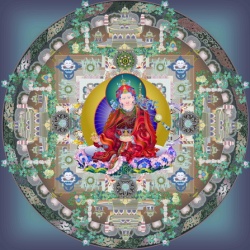How things exist - according to Buddhism and Science
At a time when the old feud between science and religion is flaring up again, and common ground between fact and faith seem to be diminishing, one particular branch of Buddhist philosophy may offer some basis for dialog. That branch of philosophy is ontology - or how things exist. Buddhist ontology clearly defines the similarities and differences between the spiritual and scientific worldviews.
Impermanence and Process Philosophy
Buddhism is a process philosophy; it regards change and flux as more fundamental than ‘things’, or ‘things-in-themselves’.
According to Buddhism, every functioning object is impermanent and constantly changing. In order to produce a change, all things must themselves undergo change. This has of course been familiar to science from Newton’s times, with every action producing an equal and opposite reaction.
Subsequent investigations have revealed that impermanence is pervasive, right down to the interactions of subatomic particles, which can only interact by giving and taking something of themselves, usually photons and gluons.
And as well as going all the way down, impermanence goes all the way up, so things that previous generations regarded as permanent fixtures are now known to by dynamic. Continents move, collide and break up. Stars, like our sun, are formed out of debris of previous stars. They burn themselves out then either explode or collapse
So with regard to impermanence, Buddhism and science are in increasing agreement
The Three Modes of Existential Dependence
‘One single rose arises from its causes, exists in dependence upon its parts, and exists as a mere imputation by conceptual thought.
There are not three different roses but one rose existing in three different ways.’
- Geshe Kelsang Gyatso in Joyful Path of Good Fortune p349
This is where the difference between the Scientific Materialist (Physicalist) and Buddhist interpretations of reality become apparent.
Buddhists claim that three modes of ‘existential dependence’ are necessary to explain the world - dynamics, structure and mind.
Physicalists say that only two modes - dynamics and structure - are needed, with the mind being reducible to the first two.
In this context, near synonyms for ‘dynamics’ are ‘causality’, ‘function’ and ‘process’.
Near synonyms for ‘structure’ are ‘mereology’, ‘composition’ and ‘arrangement’
Physicalism is a reductionist interpretation of science, which claims to explain all mental factors in physical terms. (There are also more participatory interpretations of science in which the observer is part of the system - e g Copenhagen interpretation of quantum mechanics - but these, whether they acknowledge it or not, are closer to Buddhism than to reductionist physicalism.)
Physicalism and the Church-Turing Thesis
Fortunately, for the sake of discussion, there is a clear-cut definition of physicalism based on the Church-Turing thesis. To be a purely physical system, a phenomenon must be capable of being completely simulated by algorithms acting on datastructures (without any unexplained remainder).
Buddhists would claim that there is always going to be an unexplained remainder, because algorithms and datastructures are not self-interpreting, with any assignment of ‘meaning’ having to come from outside the system.
So how does this apply to Roses?
The complete quote from Geshe Kelsang is
‘There are three levels of dependent relationship: gross, subtle, and very subtle. Every functioning thing that we perceive directly is gross dependent-related. For example, a rose arising from its causes is gross dependent-related. However, the rose existing in dependence upon its parts is subtle dependent-related, and the rose existing as a mere imputation by thought is very subtle dependent-related. One single rose arises from its causes, exists in dependence upon its parts, and exists as a mere imputation by conceptual thought’
Causality
We can easily see how a rose can arise from its causes - rose bush, water, nutrients, sunlight etc without paying too much attention to the rose itself.
Structure
The dependence on parts is a bit more subtle. We need to look more closely at the rose to appreciate the complete anatomy of what it is in terms of its parts, which may not be grossly obvious. We may need a microscope to see the pollen and cells of the petals. And the cells have components and subcomponents.
Dependence on mental designation
The third mode of dependent existence, dependence on the mind of the observer, is even more subtle, and is best demonstrated by examining the arbitrary way that a rose comes into and goes out of existence.
Is a green shoot a rose?
Is a green bud a rose?
Is a bud showing some petal color a rose?
Has it become a rose when you can see all the petals?
Has it ceased to be a rose when the first petal has fallen?
…or a majority of petals, or all the petals?
Or do you have to wait till it becomes a rosehip until it ceases to be a rose?
There is no rule which tells us at exactly what stage it becomes a rose and at what stage it ceases to be one.
The decision is a subjective one, made by how closely the botanical specimen in our hand matches a ‘generic image’ or picture of a basic rose in our mind. And the judgement will differ from person to person.
There is no fixed specification for a rose ‘out there’ that tells us when an opening bud becomes a flower, or when a fading flower becomes a hip, any more than there is for when a high-sided tray becomes a box, or at what stage of disassembly Milinda’s chariot becomes a heap of firewood.
Neither is there any permanently existing 'specification' , 'divine blueprint' or 'ideal form' of the various rose species that differentiates them one from another, or from other members of the rose family.
Looking back along the evolutionary timeline, the judgement as to when and at what point the ancestral rosoid became a rose, is quite arbitrary.
The involvement of the observer’s mind in creating reality is very subtle for everyday objects, but becomes more obvious at the quantum scale of reality.
'Tis the last rose of summer left blooming alone
All her lovely companions are faded and gone
No flower of her kindred, no rosebud is nigh
To reflect back her blushes and give sigh for sigh
I'll not leave thee, thou lone one, to pine on the stem
Since the lovely are sleeping, go sleep thou with them
Thus kindly I scatter thy leaves o'er the bed
Where thy mates of the garden lie scentless and dead
So soon may I follow when friendships decay
And from love's shining circle the gems drop away
When true hearts lie withered and fond ones are flown
Oh who would inhabit this bleak world alone?
This bleak world alone
- Sean Robsville




